
Nafplio
Today we woke up docked in Nafplio on the Peloponnese, “one of the most romantic cities in Greece,” according to the Daily Program the ship publishes each morning. It boasts a “medieval old town with narrow cobblestone alleys and neoclassical mansions with bougainvillea trees adorning the balconies.” They got the part about the bougainvillea right, as they were abundant and absolutely beautiful. Nafplio was chosen as the first capital of the Hellenic Republic In 1821, when multiple Greek city-states formed a confederation to fight against the Venetians who had occupied their land for more than two hundred years. It remained the capital until 1834, when the government of the newly independent Greek state moved to Athens.
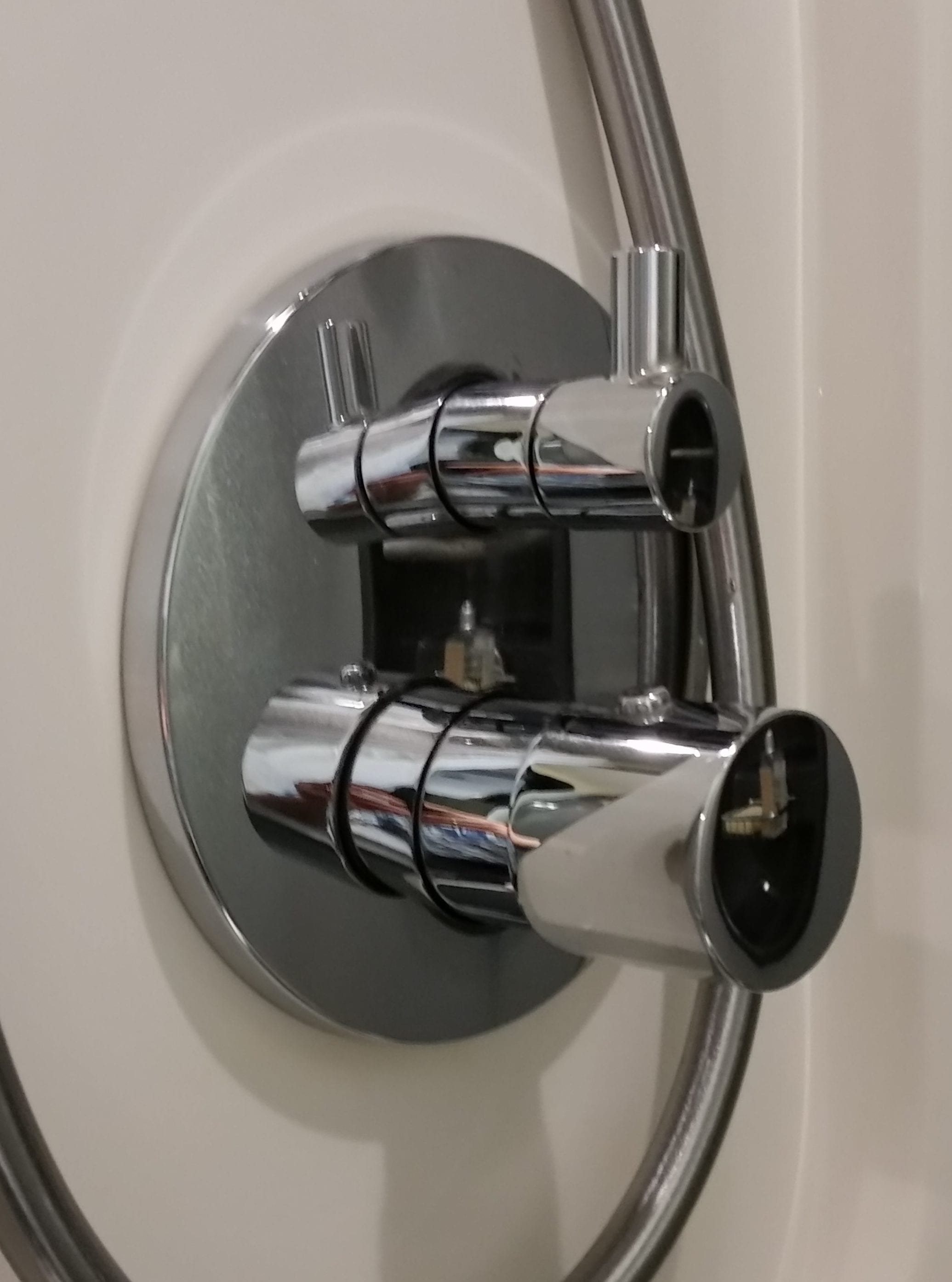
Shower controls
Before our explorations could begin, we had to complete our first challenge of the day: figuring out how to use the shower. Our stateroom is very comfortable, with a queen-size bed, a small sitting area with a table, adequate dresser and closet space, and a bathroom with a granite countertop and separate, futuristic-looking cylindrical pods for the toilet and the shower. The latter is equipped with an overhead shower head, a handheld head on a hose, and two minuscule chrome cylinders protruding from the wall. After discovering that neither cylinder pulled nor pushed, Nancy eventually figured out how to manipulate their rotating levers to get comfortably warm water flowing in the right direction–and then passed on her hard-won knowledge to Michael.
Breakfast on the Wind Star is served in the Veranda restaurant, also the site of the lunch buffet. Options include a fresh fruit bar, a pastry bar, a cold cereal bar, a hot-items bar, and an omelet station. And the juice selections include passion fruit! In the unlikely event that you cannot find what suits you at the buffet, you can order Eggs Benedict, French toast, waffles, or pancakes from the menu. With our stomachs trés satisfaits, we were eager to go ashore and discover more of Greece.
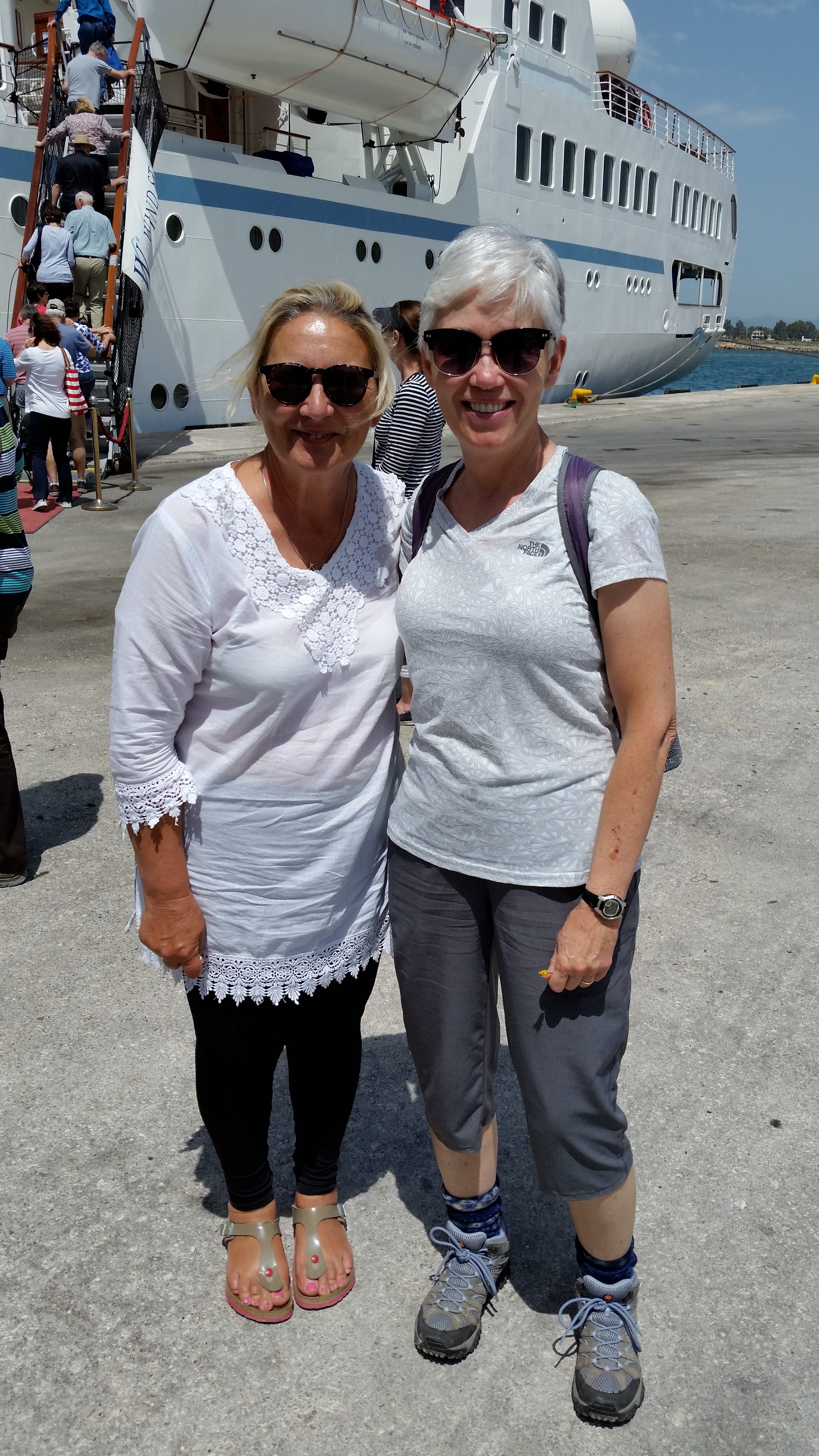
Nancy and our guide Kristina
While most of the Wind Star’s passengers would be either spending a lazy Sunday on the beach in Nafplio or boarding a bus to explore the ruins of ancient Mycenae, the Gee Group boarded its own bus and headed toward the ruins of ancient Corinth. During our 45-minute drive north through the province of Argolis, we passed grove after grove of powerfully fragrant orange trees, then olive trees, and then vineyards as the elevation increased. This was the country of Agamemnon, the Mycenaean king who led the united armies of Greece against the Trojans in the distant, mythical past. According to what we learned from Kristina, our guide for the day, the locals must speak of Agamemnon as fondly as Virginians do of Mr. Jefferson. From the narrow road we saw few modern villages, but several examples of the area’s prehistoric “cyclopean” walls, so-called because later inhabitants thought that only the giant Cyclops could have constructed them with such huge, uncut stones.
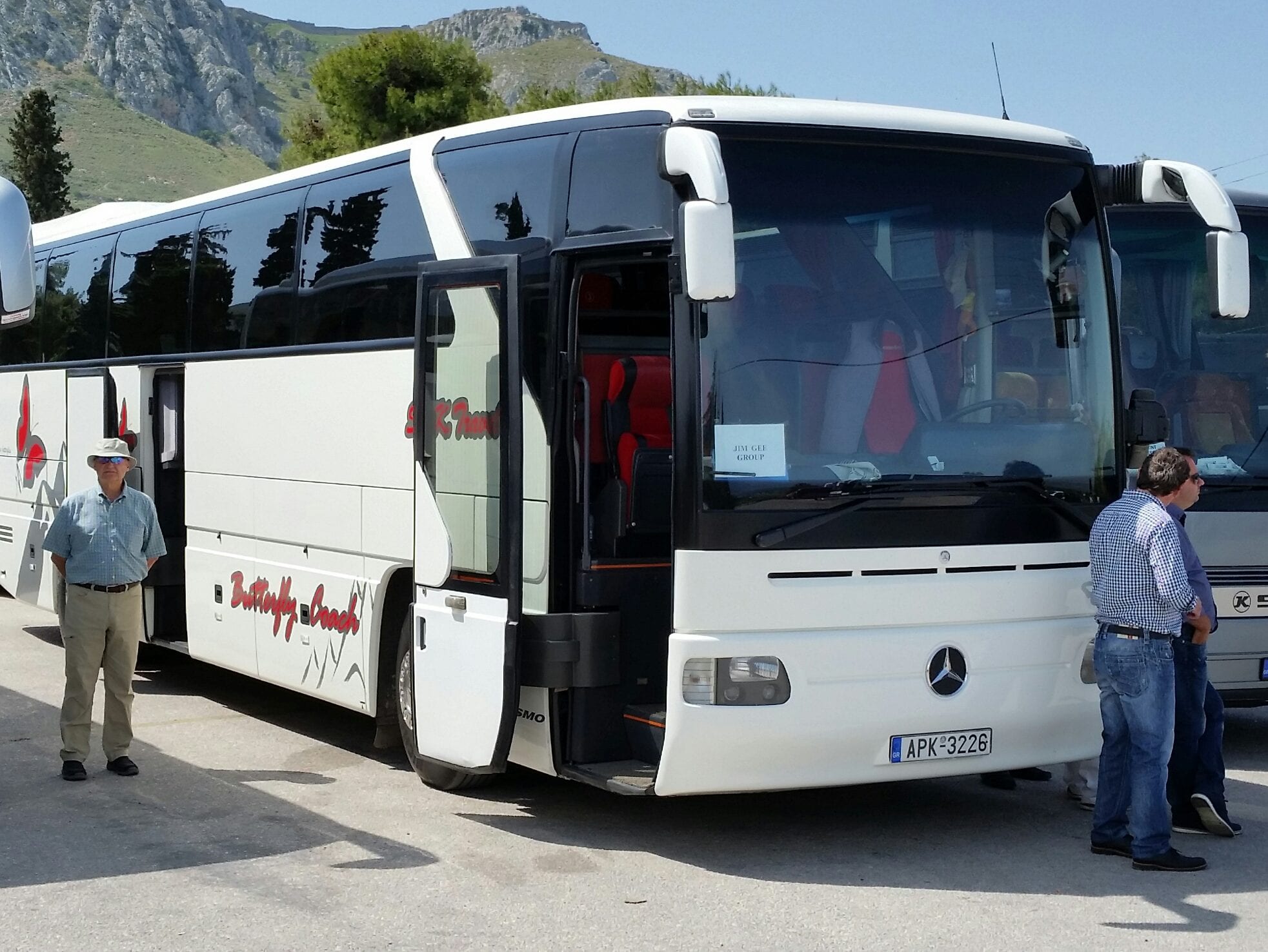
Our coach to Corinth
Corinth is located on the narrowest strip of land that divides the Aegean Sea from the Ionian/Adriatic while connecting the Peloponnese with the Greek mainland. The site has been inhabited since 6000 BC, making it one of the oldest cities in the world. Early settlers chose this isthmus not only for its strategic location, but also because the area boasts abundant springs, as well as beds of exceptionally fine clay for pottery. Unsurprisingly, ancient Corinth was attacked and conquered multiple times, with rampant destruction on each occasion. The last major sacking took place around 150 BC; Julius Caesar began rebuilding about a hundred years later, so most of the extant ruins date from the classical Roman period. At its peak, the city boasted nearly a million residents; today there are about 100,000.
The most significant archaeological sites in Corinth are around the agora, the central marketplace. Most prominent is the Temple of Apollo, built before the Roman conquest, probably around 540 BC. What is distinctive about this structure is its monolithic columns. Unlike those of the Parthenon in Athens, each of these columns is one solid shaft of limestone, measuring over 23 feet in height and more than 5 feet in diameter at the base, covered with a layer of marble stucco.
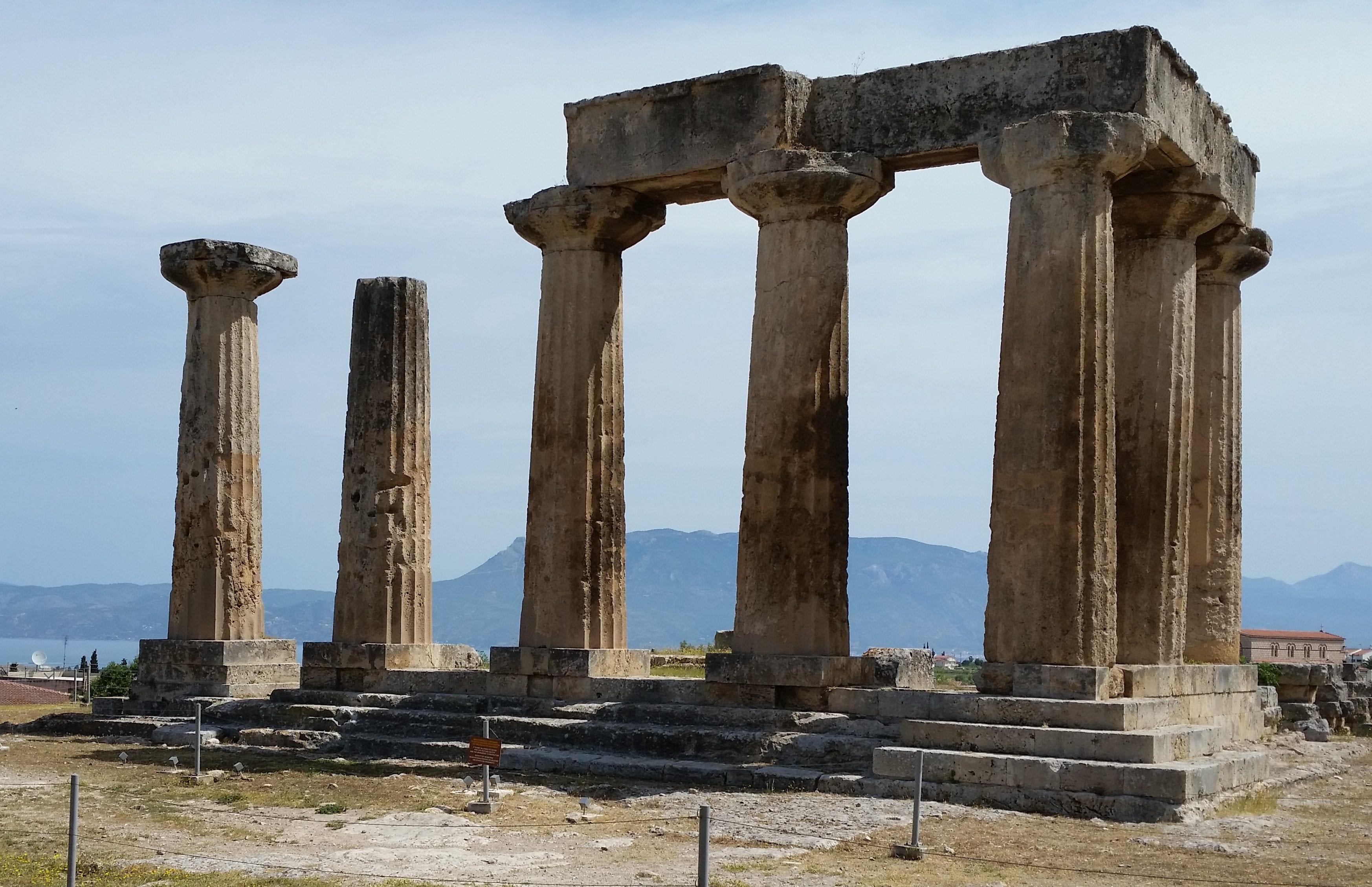
The Temple of Apollo exemplifies the Doric architectural order. One would think that the Corinthian order would prevail in this town, but that more elaborate style, characterized by narrower columns and intricately carved, organic capitals, did not develop until after the Temple of Apollo had been built
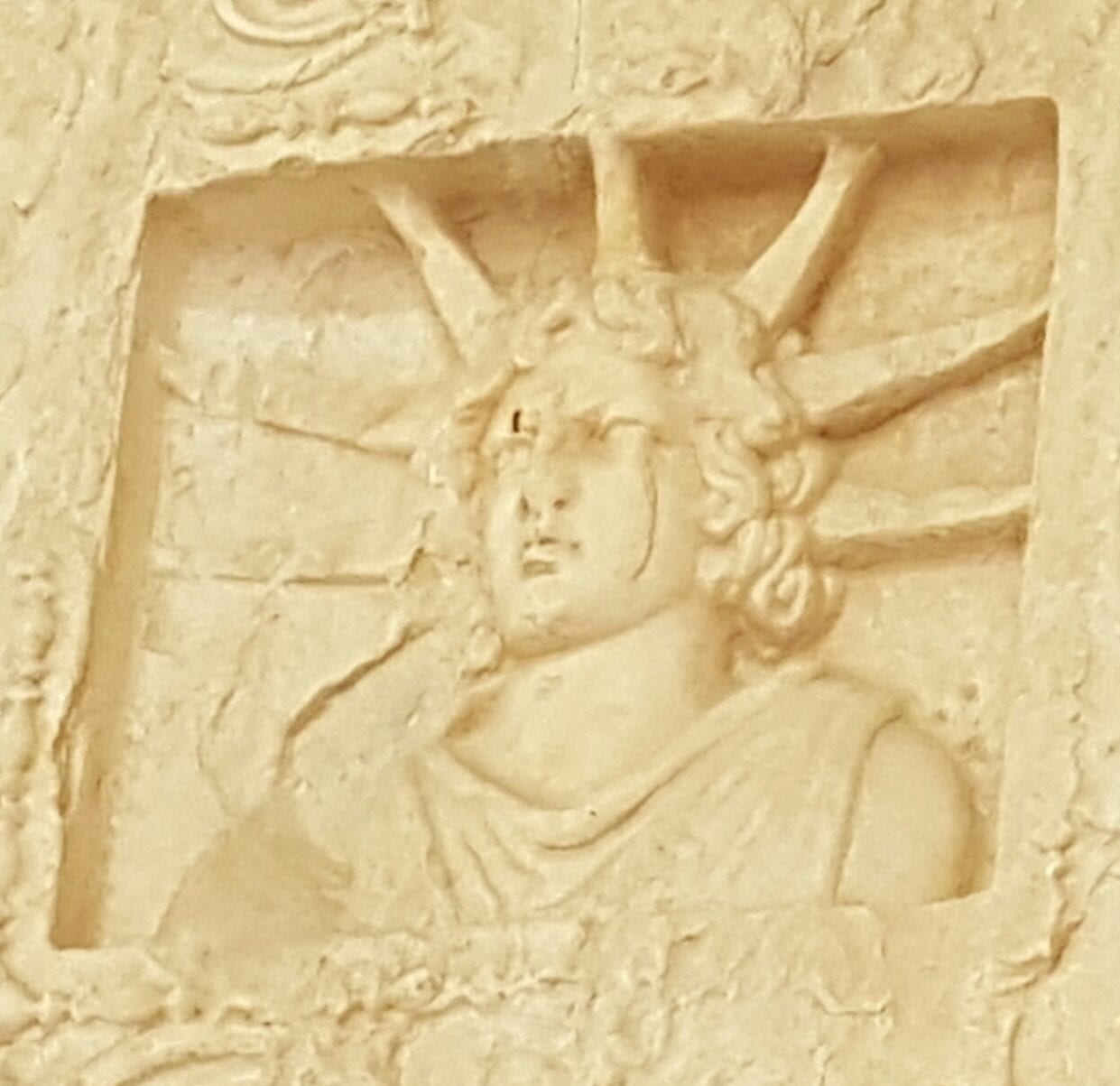
Apollo often is represented as the embodiment of the sun
There is also a fairly well-preserved fountain named for Glauke, the daughter of Creon, mythological king of Corinth. According to legend, Glauke became engaged to Jason, leader of the Argonauts, after he had obtained the Golden Fleece. Their engagement broke the heart of Medea, the sorceress who not only
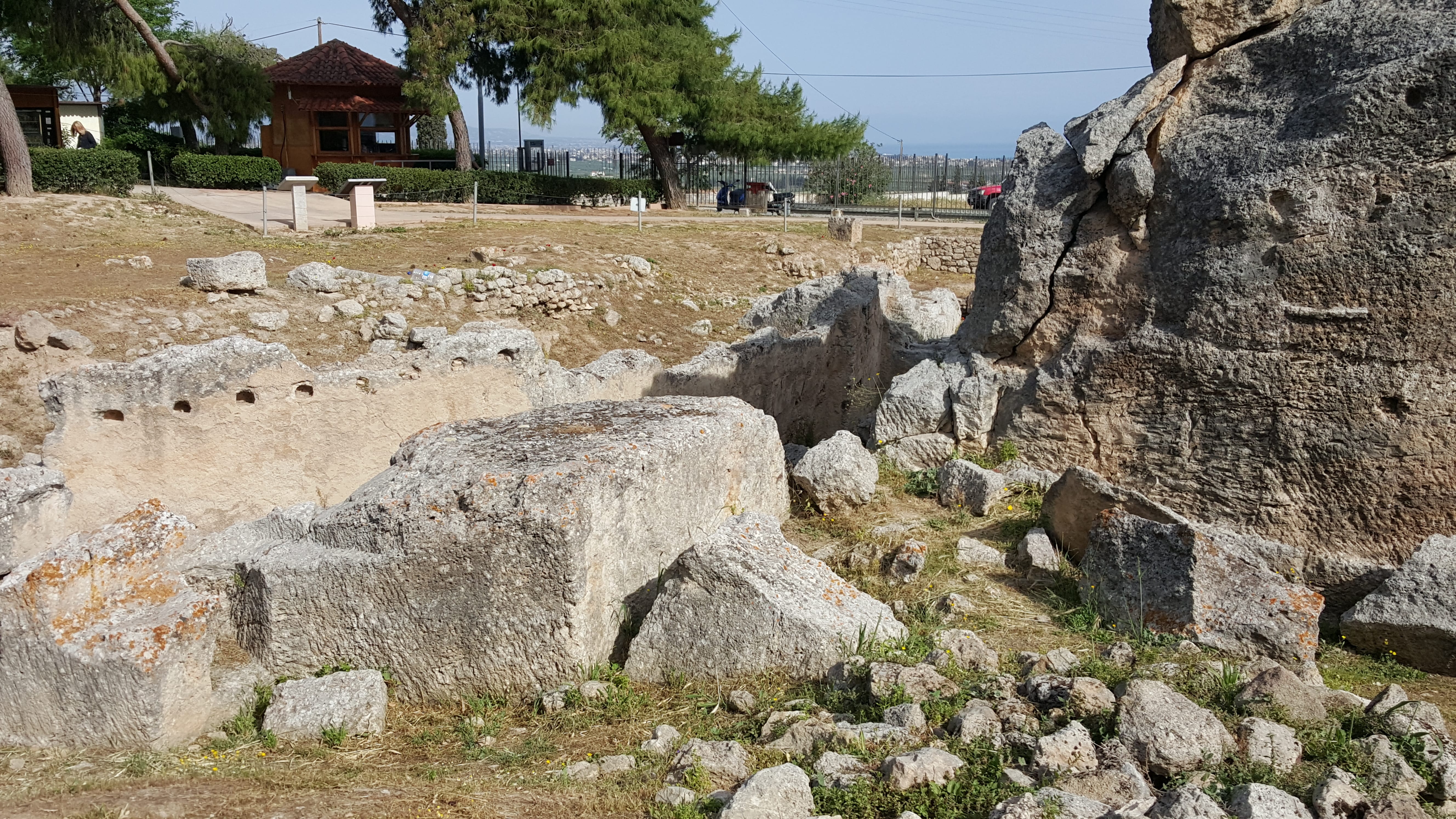
Fountain of Glauke
had helped Jason succeed in his quest, but had borne him two children. As a wedding gift, Medea sent her rival a dress impregnated with some highly flammable substance. When Glauke tried it on, it burst into flames, setting the palace as well as the princess afire. Glauke vainly attempted to save herself by jumping into this fountain, but both she and Creon, her father, died in the blaze.
Somewhere in this vicinity Alexander, the great conqueror, encountered Diogenes, the famous philosopher, one chilly morning while the latter was sitting in the warmth of the sun. Thrilled to meet the influential thinker, the young Alexander said, “Diogenes, I am at your service. What may I do for you?” According to legend, the aging cynic replied, “You can move out of my sunlight.” Alexander laughed heartily and declared, “Were I not Alexander, I would wish to be Diogenes.”
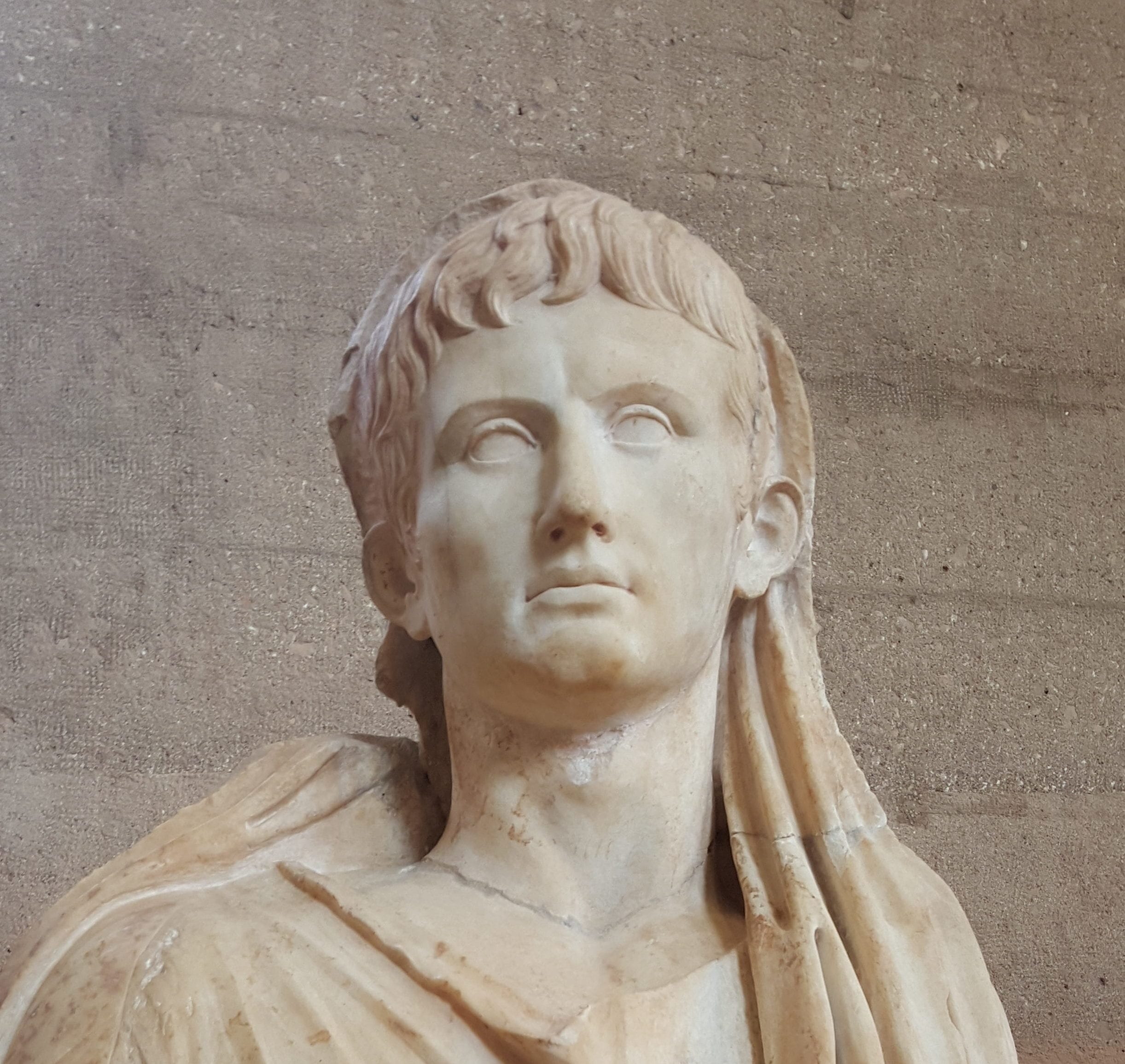
We could take all the photos we wanted of the statues of Caesar Augustus; one of our guides thought he resembled actor Steve McQueen
A modern building among the ruins houses the Museum of Ancient Corinth. Among the many interesting artifacts on display are two kouri, statues of young men sculpted in a primitive style that differs significantly from the characteristic realism of classical Greek and Roman art. These kouri, along with the graves they were marking, were discovered only seven years ago, when smugglers were caught attempting to spirit the statues out of Greece. The robbers had cut each kouros into four separate pieces to make them easier to transport; apparently, such desecration is not an uncommon fate for valuable antiquities. (We cannot include pictures because photography of the kouri and their associated skeletons was forbidden–and an unsmiling guard made sure we adhered to the rules.)
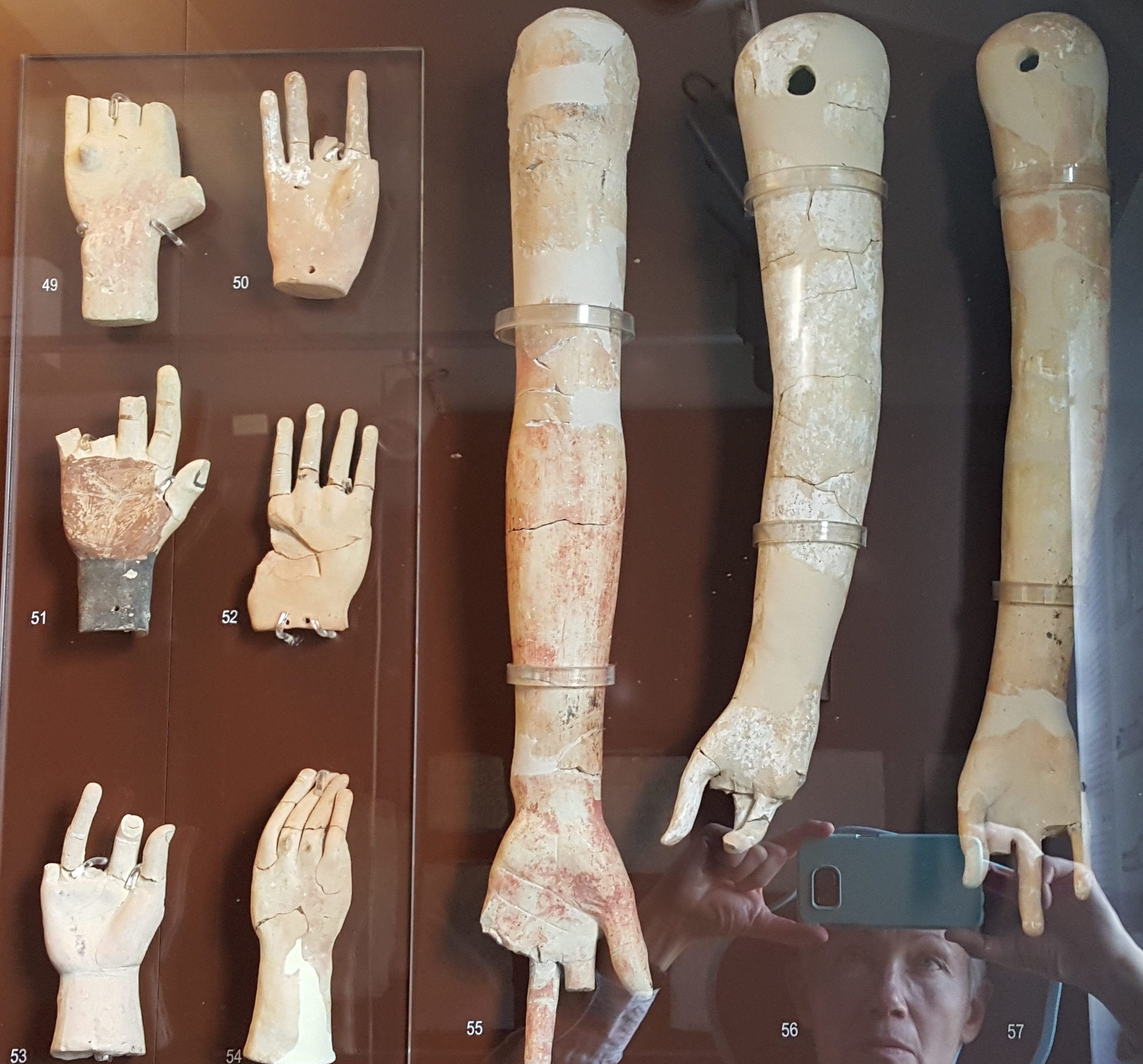
Curiosities found in the local Asclepion, a sort of combination medical clinic and temple dedicated to the god of healing. Patients who had been cured of an ailment would create (or commission) a ceramic model of the affected body part and then gratefully present it to Asclepius
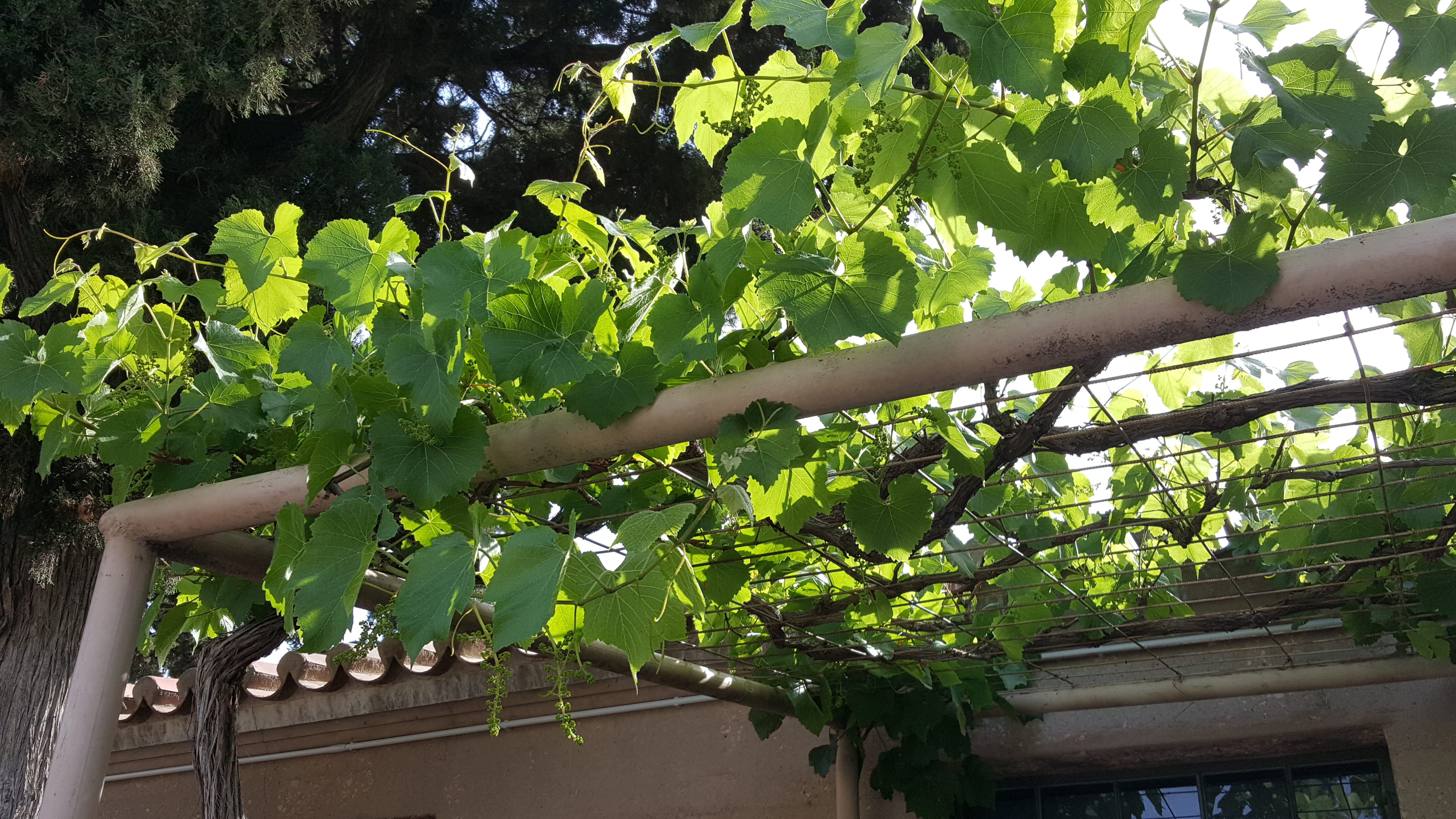
A lush grape arbor shades the inner patio of the Museum of Ancient Corinth
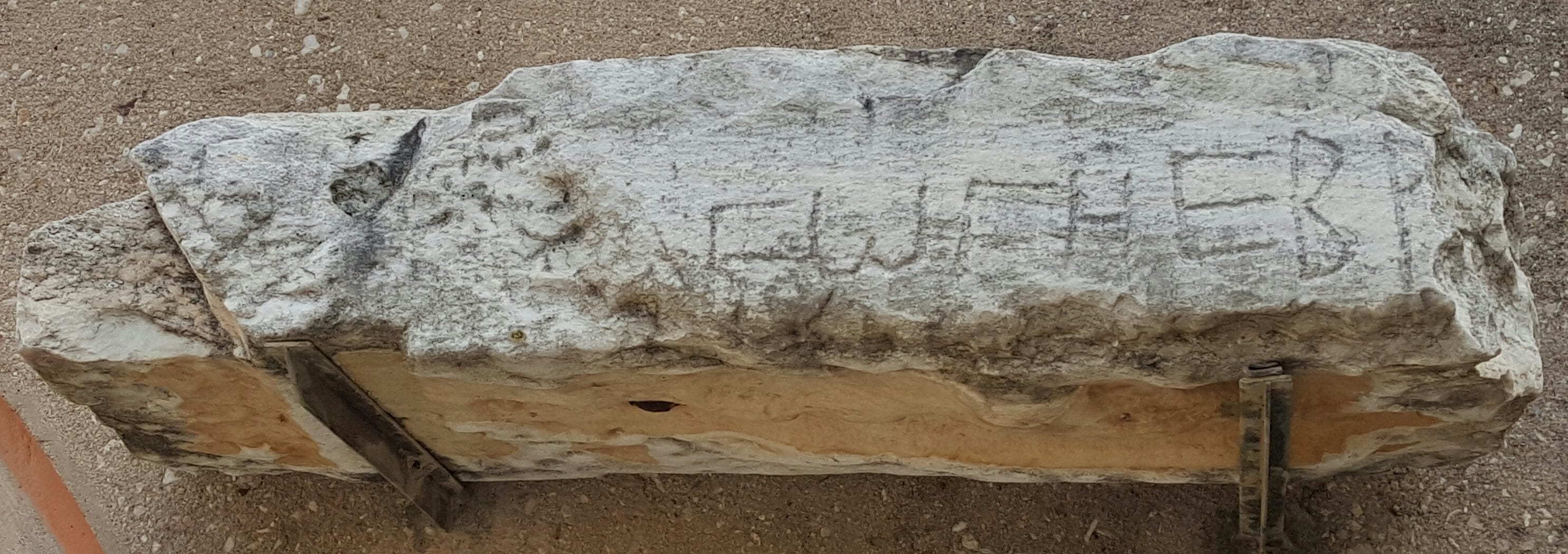
This stone, inscribed “Synagogue of the Hebrews,” was found near the Corinthian agora and dates from around the first century AD. It is thought to be the lintel of the synagogue where Paul began testifying of Christ to the local Jewish community

Another stone depicting menorahs dates from a later period
Neither the synagogue nor the homes where early Corinthian Christians met still exist, so after we had perused the museum, the Gee Group gathered under the shade of some trees behind it to learn more about what went on in ancient Corinth. Kristina, our guide, pointed out the ruined Temple of Aphrodite high on a hill in the distance, and explained that this shrine had been a major attraction to visitors in ancient times. The “virgin” priestesses who served the goddess of erotic love–functioning more as prostitutes than nuns–were renowned for their beauty and refinement. “Classical culture was very concerned with the body, with its strength, beauty, and grace. No ugliness or vulgarity was tolerated,” Kristina told us. She continued at some length about a famous Corinthian courtesan named Leyda who had entertained notables from all over the world at her luxurious villa.
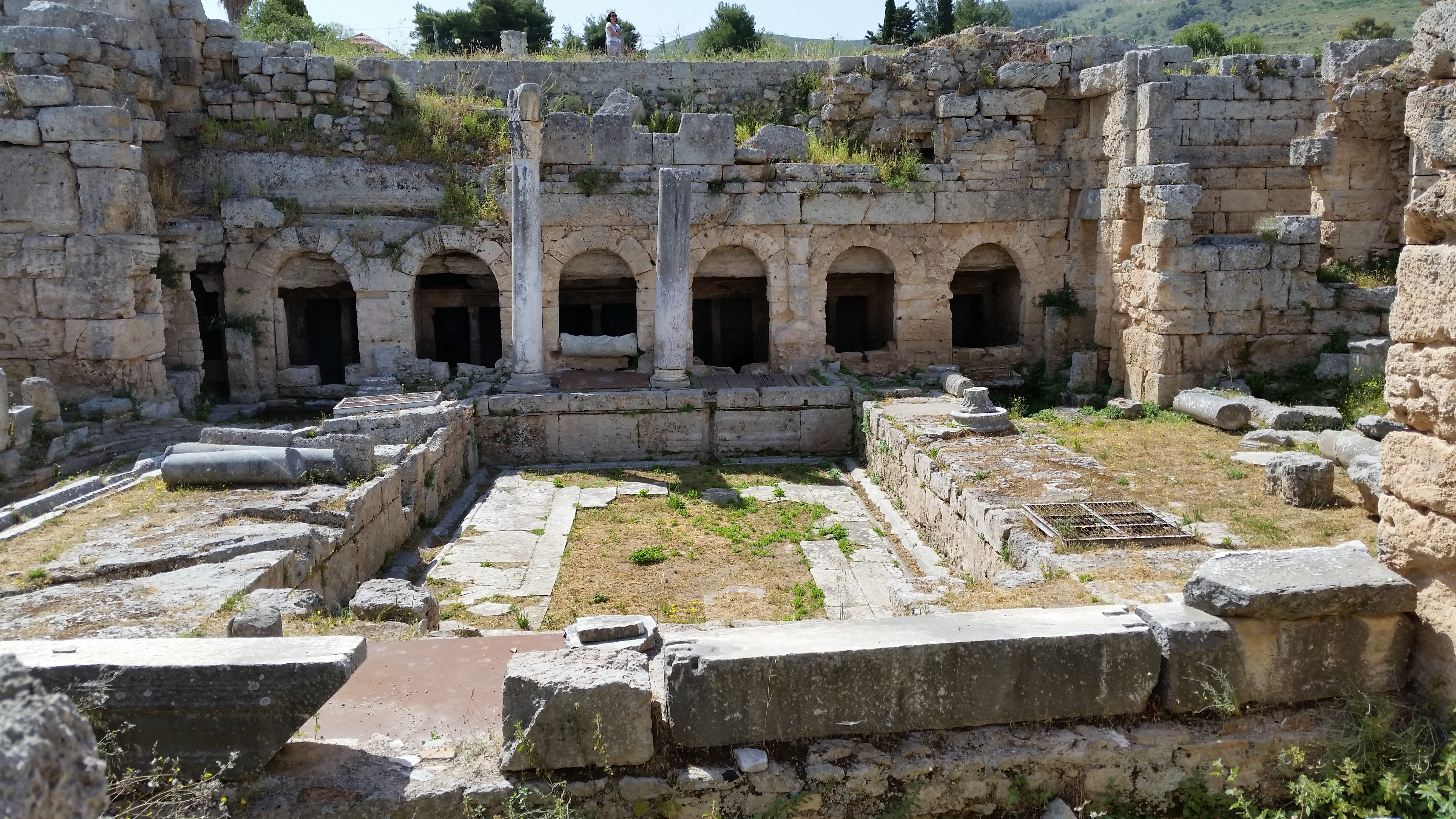
Corinthian baths
Michael and Nancy weren’t sure that our non-LDS guide’s discussion of Greco-Roman sex-worship was an appropriate prelude to the sabbath devotional we had prepared for our group this morning, but it did help everyone better understand the kinds of challenges that the Apostle Paul faced when he began preaching the Way of Christ in Corinth about 50 AD. Despite the city’s prevailing pagan culture, Paul succeeded in establishing a thriving branch of the church in Corinth, to which he returned two or three times over the next eight years. He also wrote at least four epistles to this band of Christian converts. At least one of these letters has been lost, and the order and content of the others seem to have been mixed up within the New Testament collection that we know as 1st and 2nd Corinthians, but the record we have of Paul’s interactions with the saints in Corinth contains a wealth of information about the development of early Christian doctrine and religious practice.
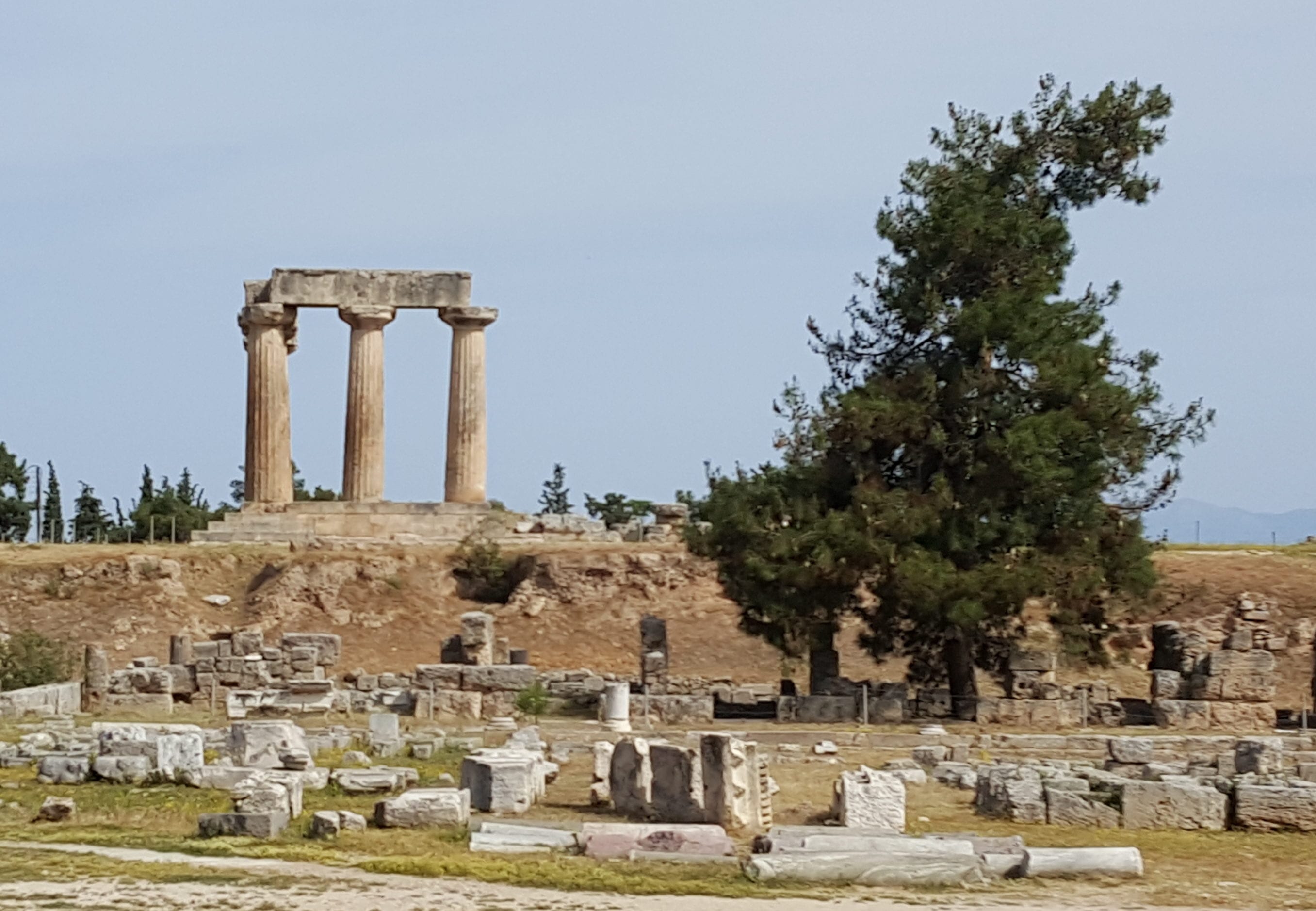
The Temple of Aphrodite, whose remains stand atop the hill in the background, drew worshippers from all over the Greco-Roman world
While acknowledging Paul’s admonition that women should keep silent during meetings, Nancy boldly proceeded to speak about his more important counsel in 1 Corinthians 11-12 that the community of saints should seek unity through the sharing of the sacrament of the Lord’s Supper, and by appreciating the value of each diverse member of the body of Christ. Michael reviewed Paul’s teaching (also in 1 Corinthians 12) about spiritual gifts, sharing the insight that our most valuable personal gifts are those that can be used to serve and edify others rather than simply gratify ourselves.
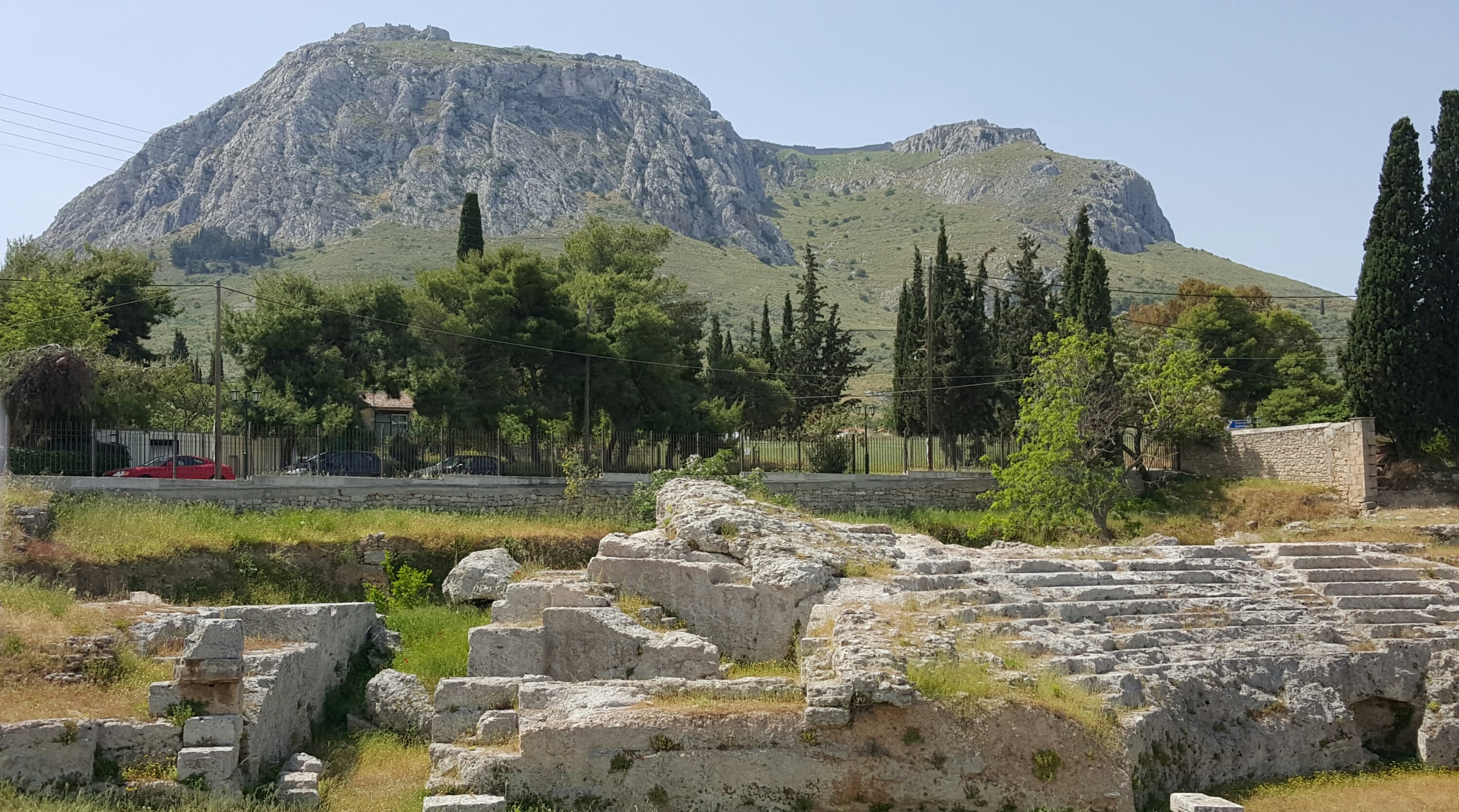
The Roman-era Odeon (concert hall)
After the devotional, we had some free time to wander–mindful of Kristina’s warnings to stay on the marked paths, not only to protect the antiquities but also because she had seen vipers in the sand during earlier visits. We admired the brilliant red poppies that had spontaneously sprung up amid the ruins, and tried to imagine how Corinth had looked during the first century. Jim pointed out the bema where Paul and other orators stood to address the crowd, but which of the empty shops might have belonged to Priscilla and Aquila, the tentmakers with whom Paul worked? What plays were performed in the amphitheater? What music wafted down the hill from the odeon to the shore of the Corinthian Gulf below?
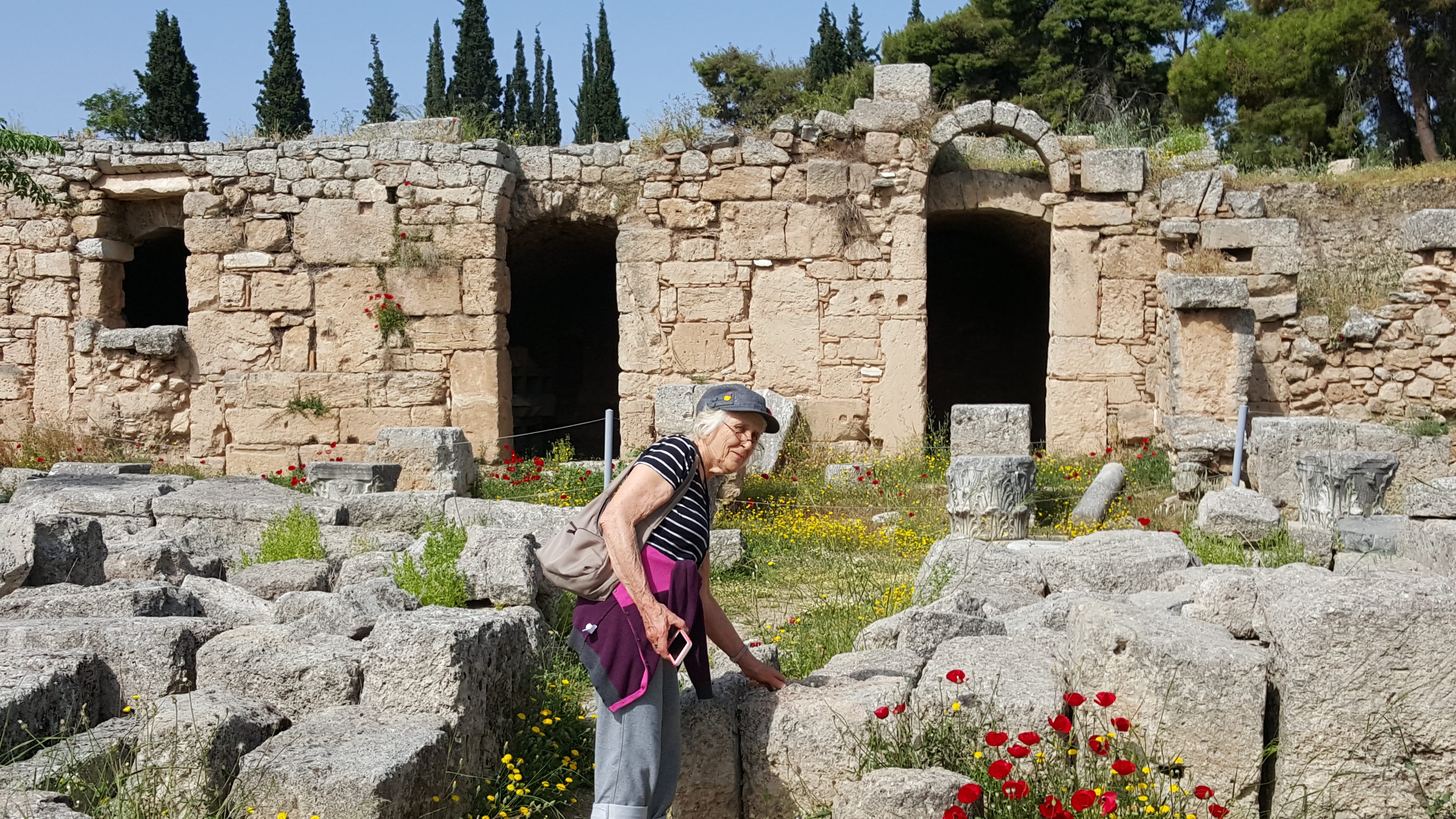
Amanda gets a closer look at some wild poppies
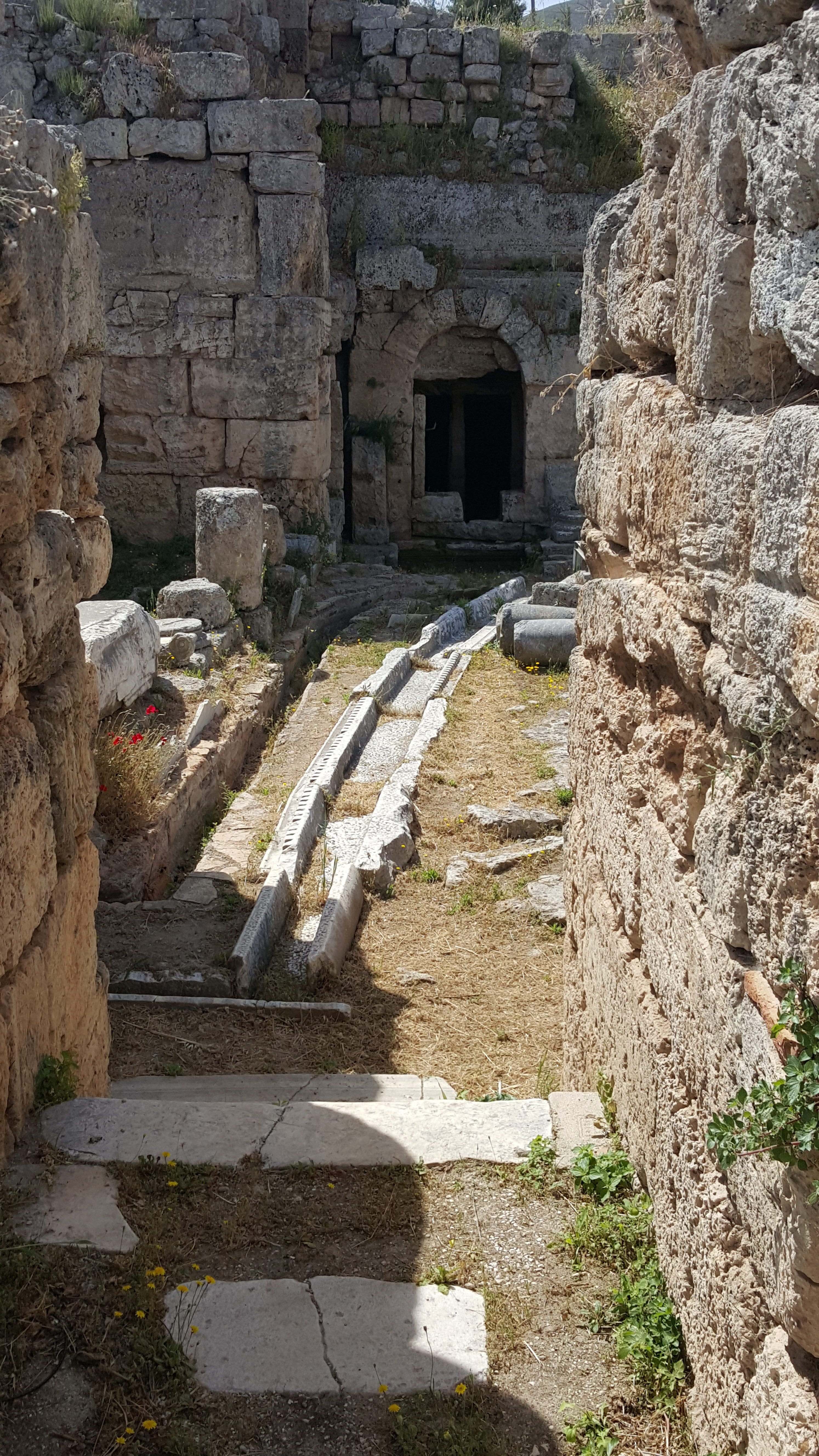
Numerous natural springs and man made conduits supplied water to Corinth’s inhabitants
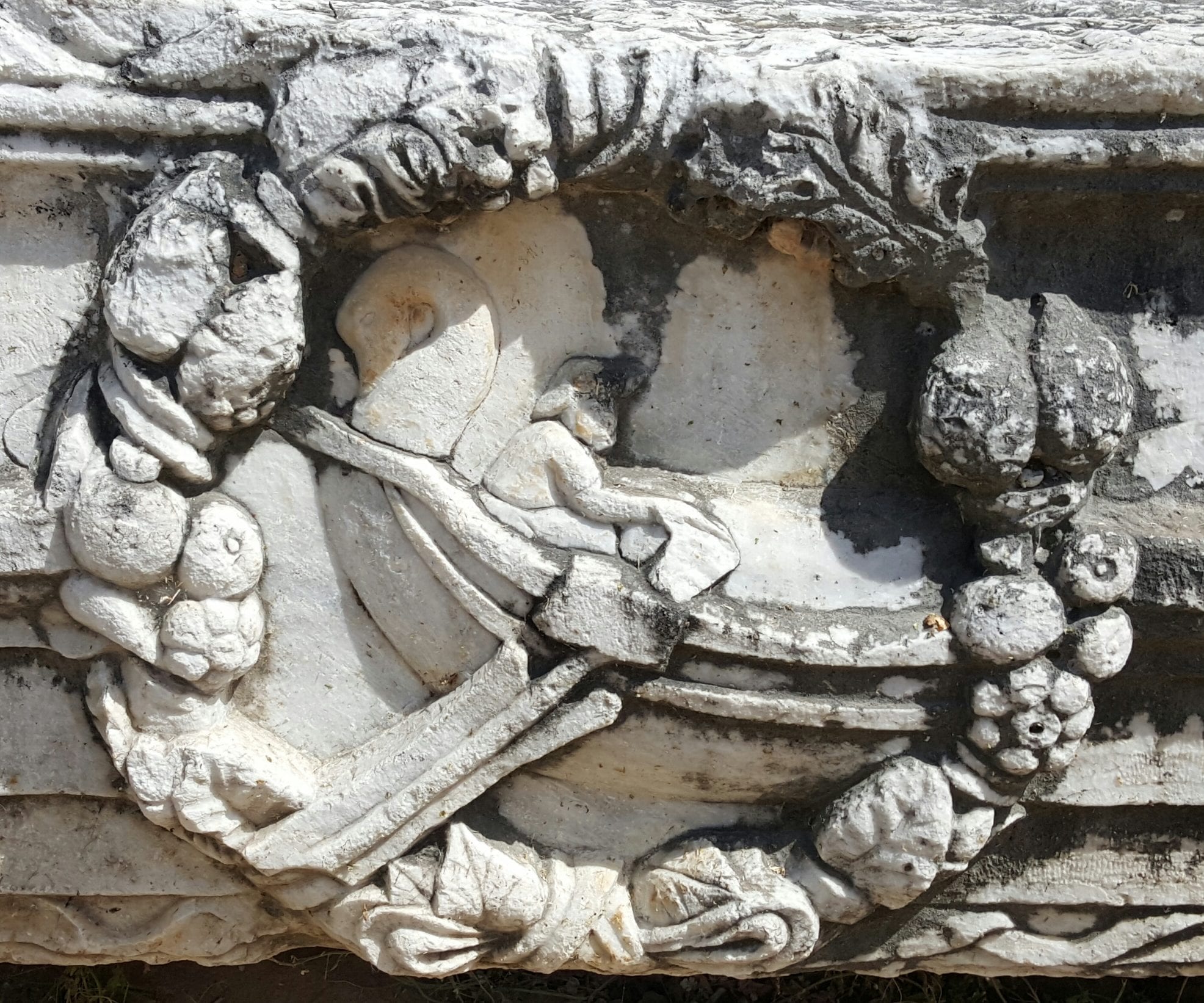
This relief sculpture, which features a wreath of fruit and flowers surrounding a sailor, celebrates the abundant life enjoyed by ancient Corinthians
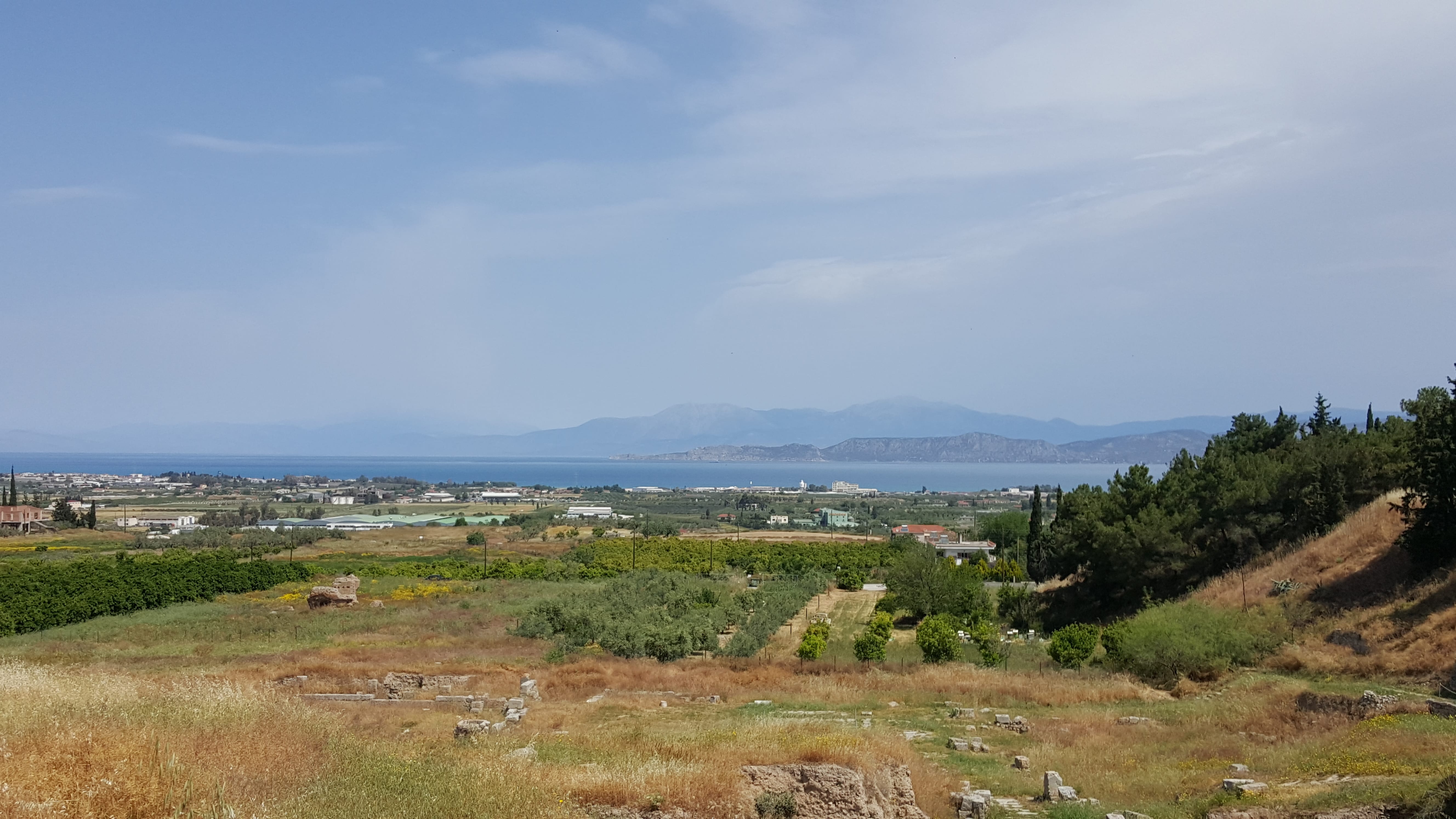
View of the Corinthian Gulf from the odeon
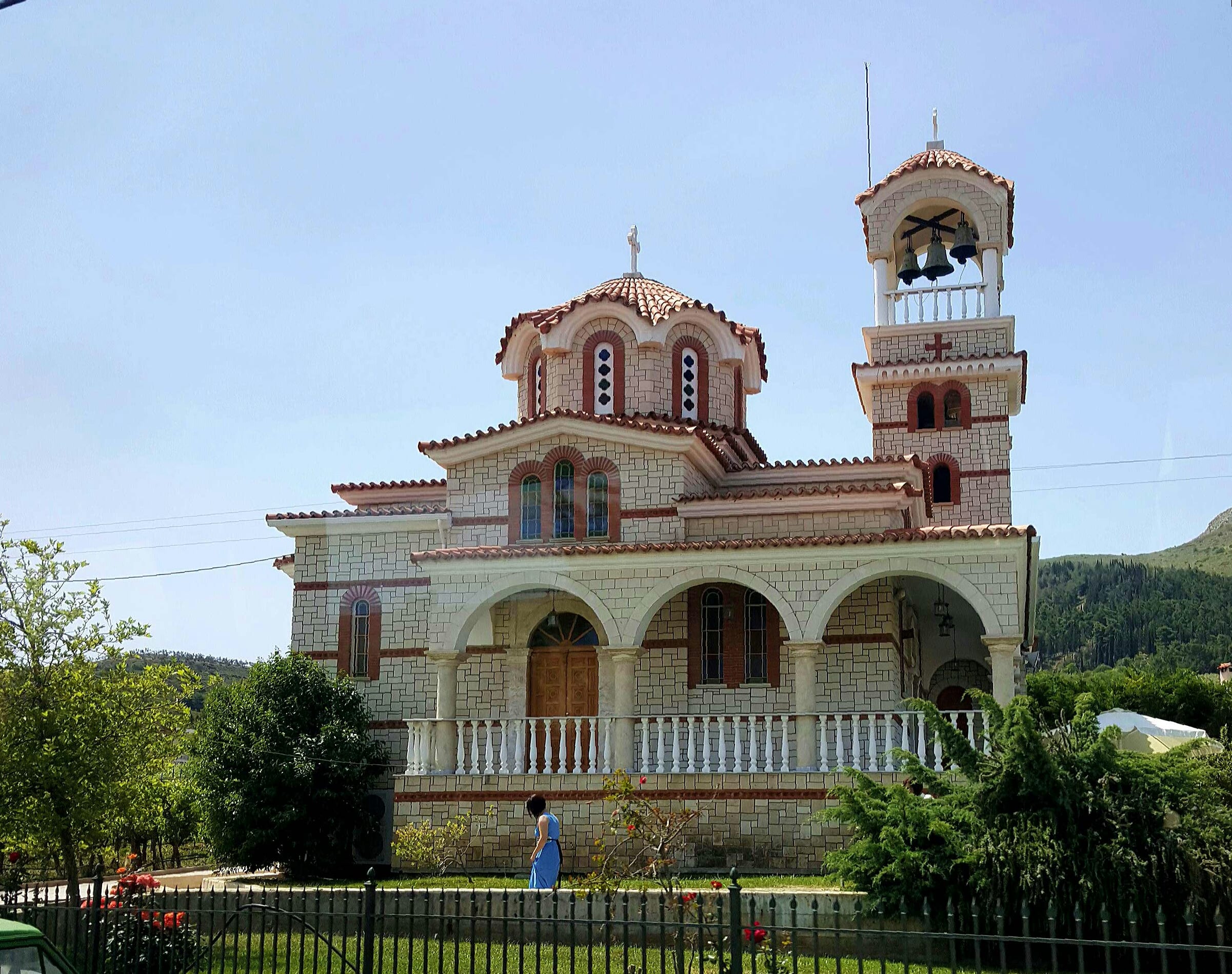
Greek Orthodox Church of St. Paul in Corinth
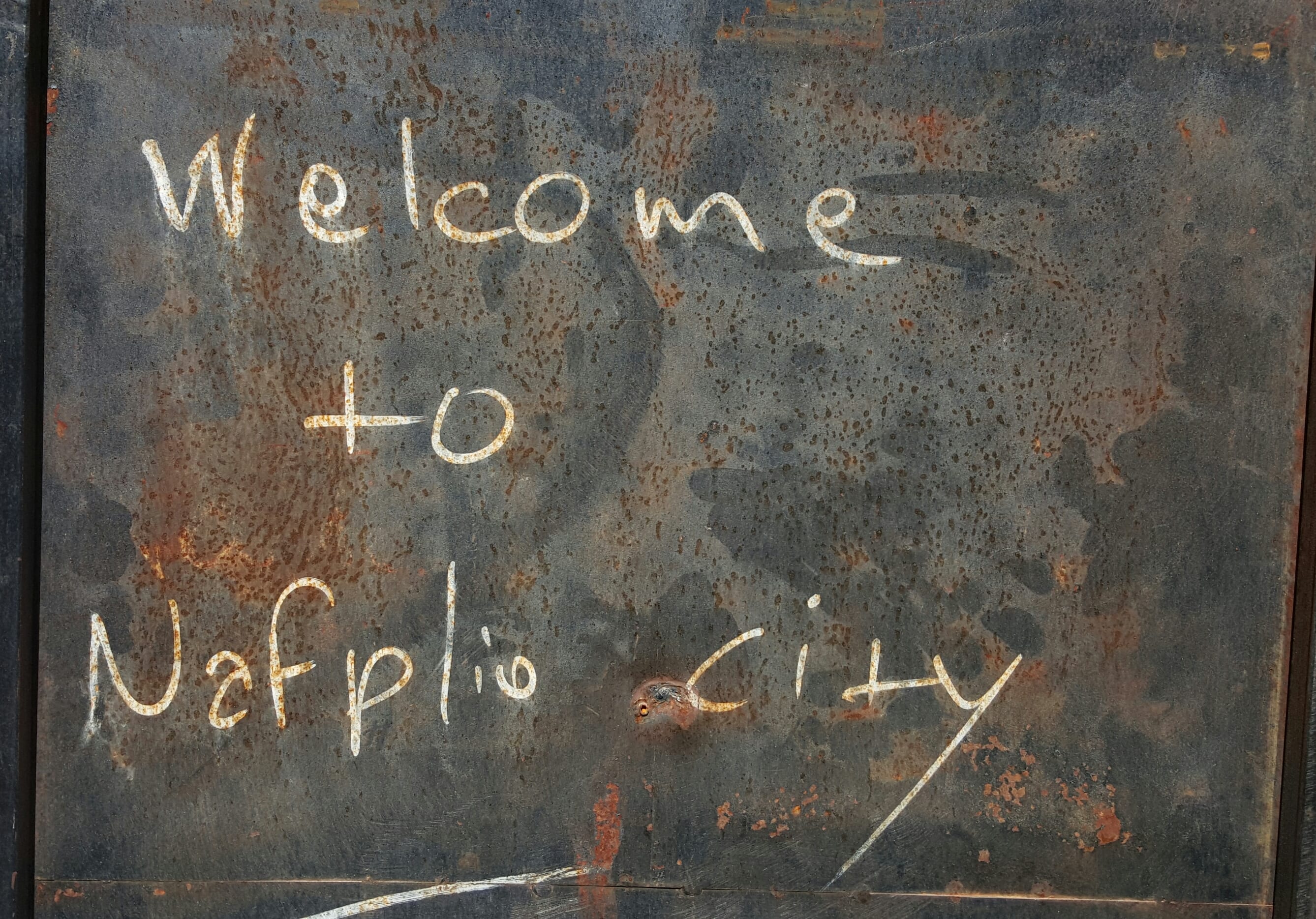
It was lunchtime when we got back to Nafplio, so we re-boarded the ship and headed for the Veranda buffet. We sat down at an outdoor table with Cathy and Jeff to talk more about Paul’s teachings in light of what we had seen and learned. After lunch, Michael and Cathy indicated that they wanted nothing more than to go below and take a nap, while Jeff expressed a desire to go ashore and climb the 900-plus steps to the Venetian-era fortress overlooking the port so that he could sketch the view. Nancy chose a middle road: she followed Jeff into town but opted to wander through its quiet back alleys, avoiding throngs of tourists in the shops and cafés near the town square. Eventually she decided to climb partway up the stairs to the fortress; 260 steps were sufficient to afford a fabulous view of Nafplio and the surrounding bay–and to avoid getting overheated in the mid-afternoon sun.
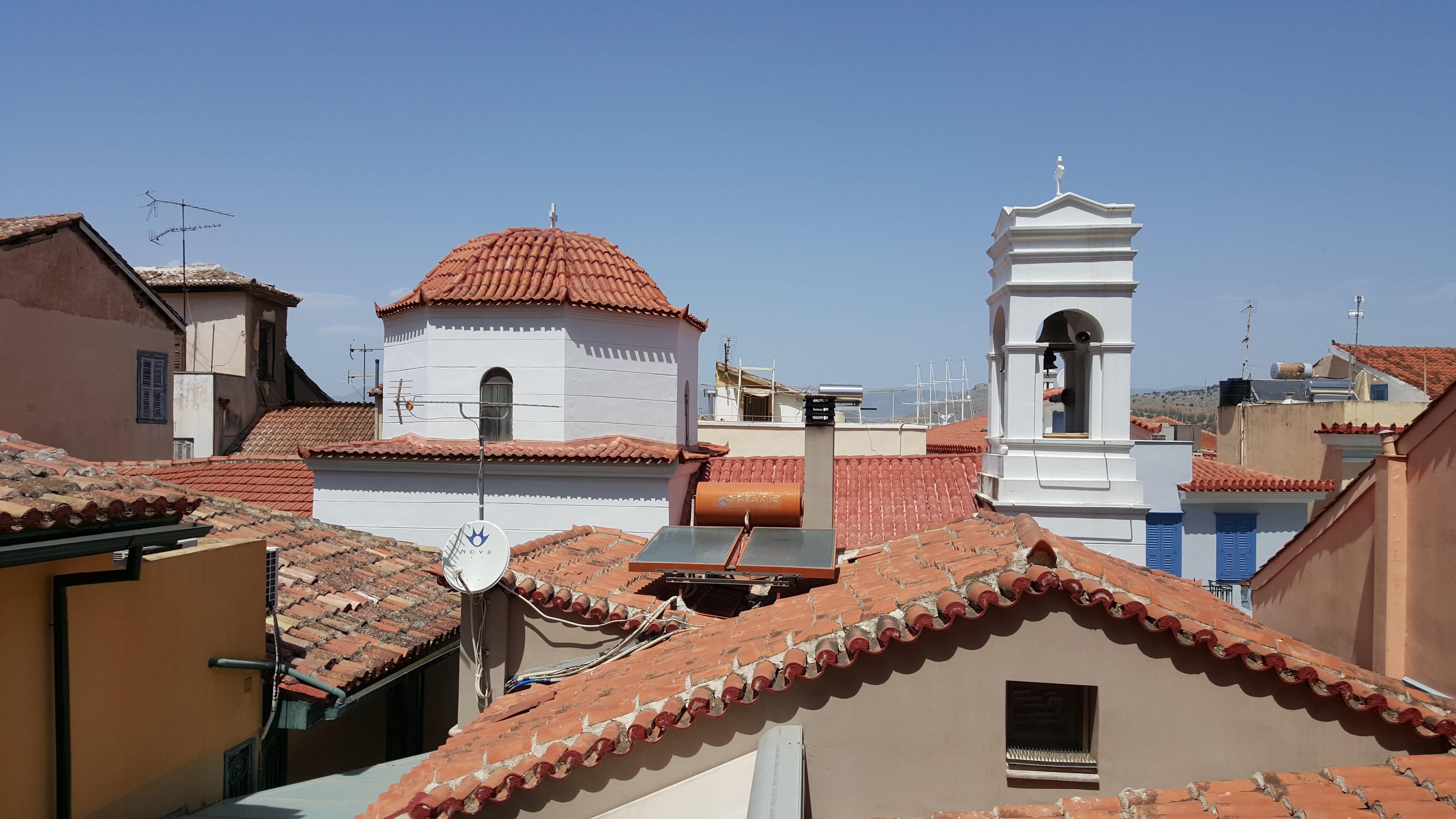
Nafplio roof tops
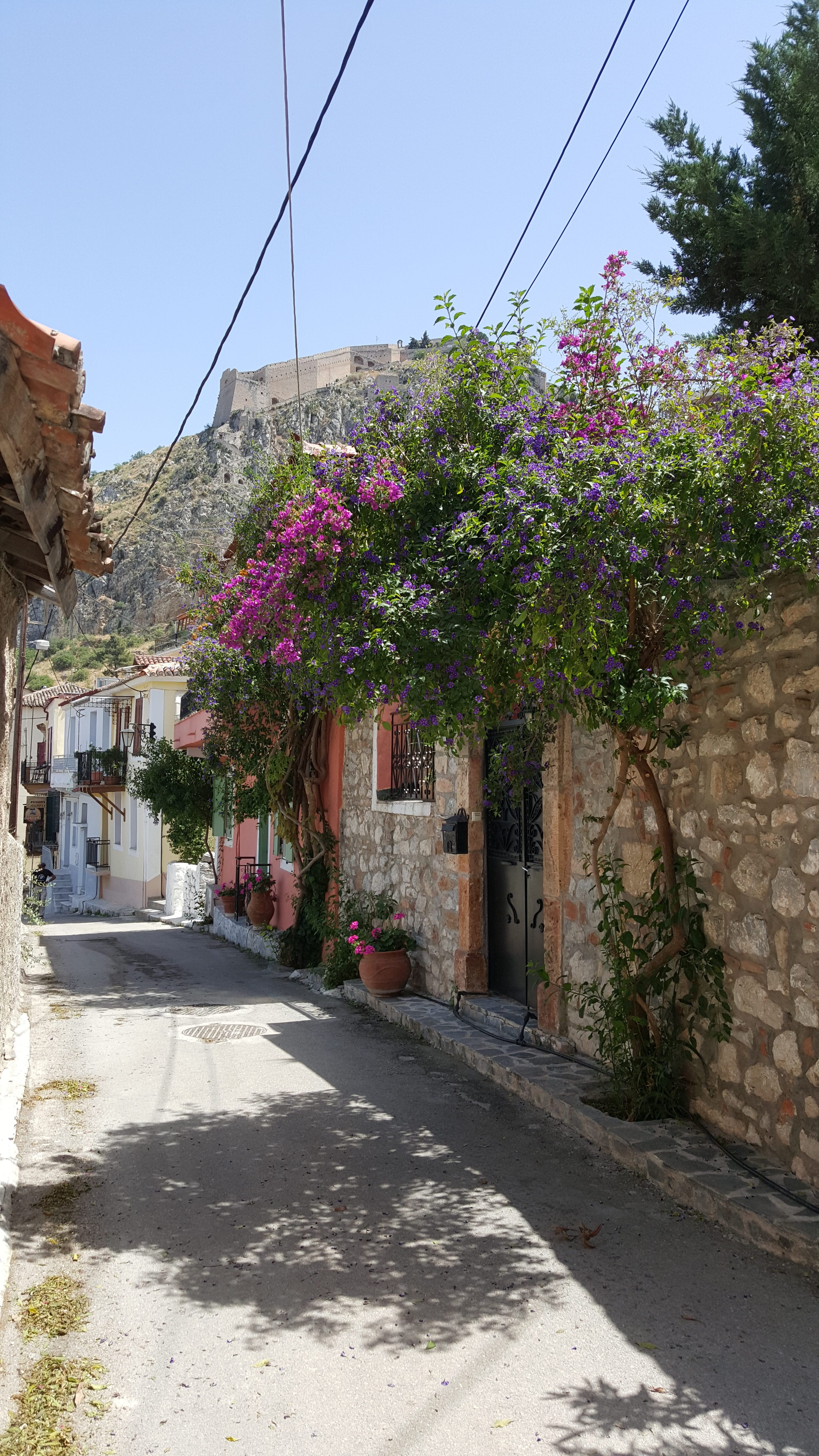
Street in Nafplio
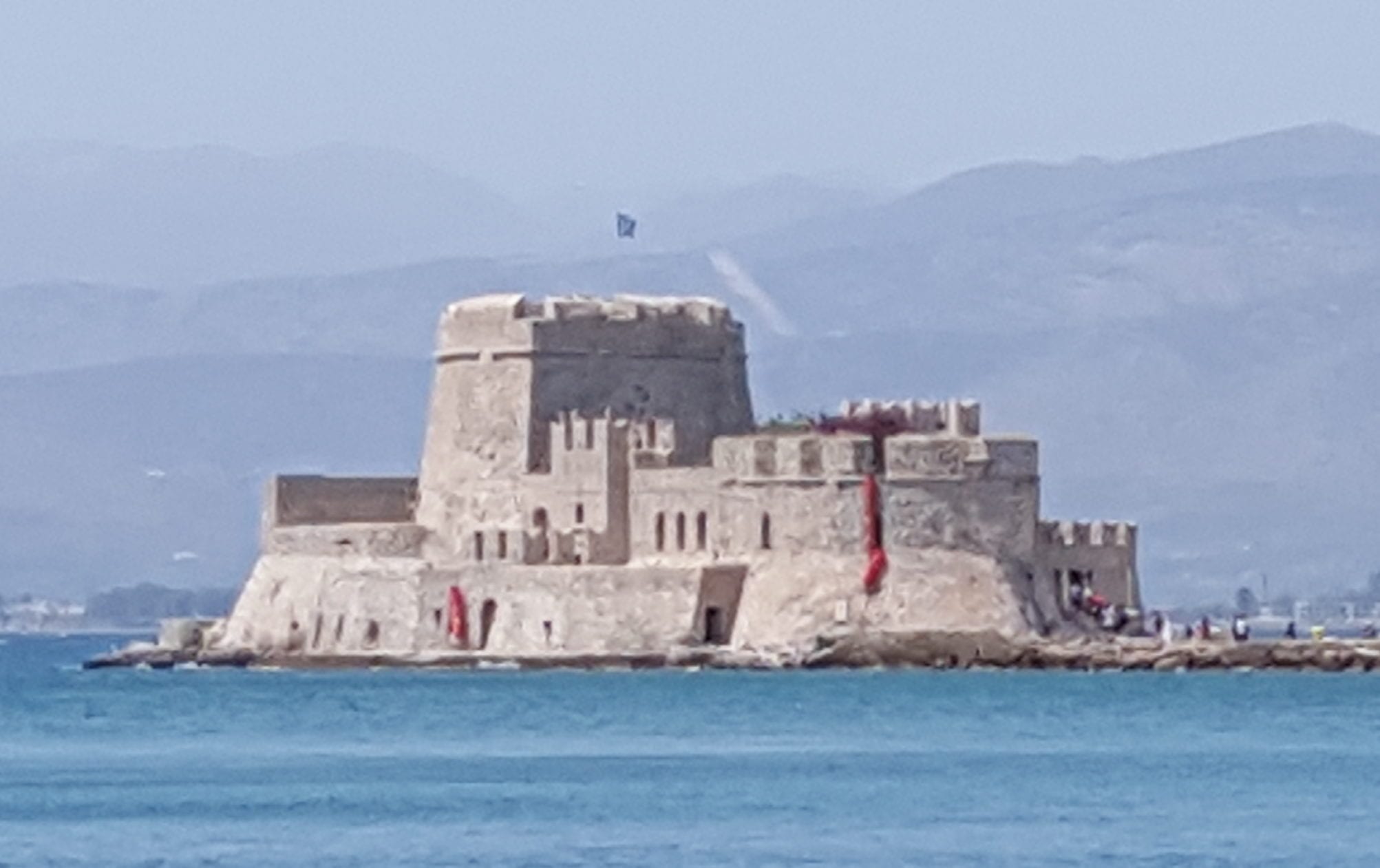
The Bourtzi fortress occupies an island in Nafplio’s harbor. It was built in 1473 to protect the city from pirates
Just before ascending the stone stairs, Nancy had stopped to talk with Barry and Eva, who were relaxing in the shade of some big trees while taking advantage of the free wifi at a nearby café. Nancy intended to join them when she returned from her hike. During her descent, she heard a loud crack, like the sound a dry branch makes when it breaks from a tree. She looked around to determine where the noise had come from, but couldn’t tell–until she got back to the table where Barry and Eva were sitting. A large, leafy limb was lying on the ground next to them, and both Barry and Eva were clutching ice packs to bruised body parts. Both had taken a direct hit, but fortunately neither had been seriously injured–mostly just stunned by the unexpected collision. Soon Nan and Keith joined the group enjoying cool drinks and free wifi in what they now recognized as the potentially dangerous shade.
Meanwhile, Michael awoke from his nap and decided to venture into town, hoping to run into someone he knew. However, Nafplio was overrun with so many other tourists (two large cruise ships also were in port) that he gave up and returned to the Wind Star. While trying to prepare the first post for this new blog, he discovered that his tablet was missing one crucial piece of software. He went to the Wind Star’s reception desk and arranged to connect to the ship’s Internet (for an exorbitant price, of course) so he could download the necessary software. Nancy spent about half an hour writing after she returned to the ship, but soon it was time to dress for dinner.
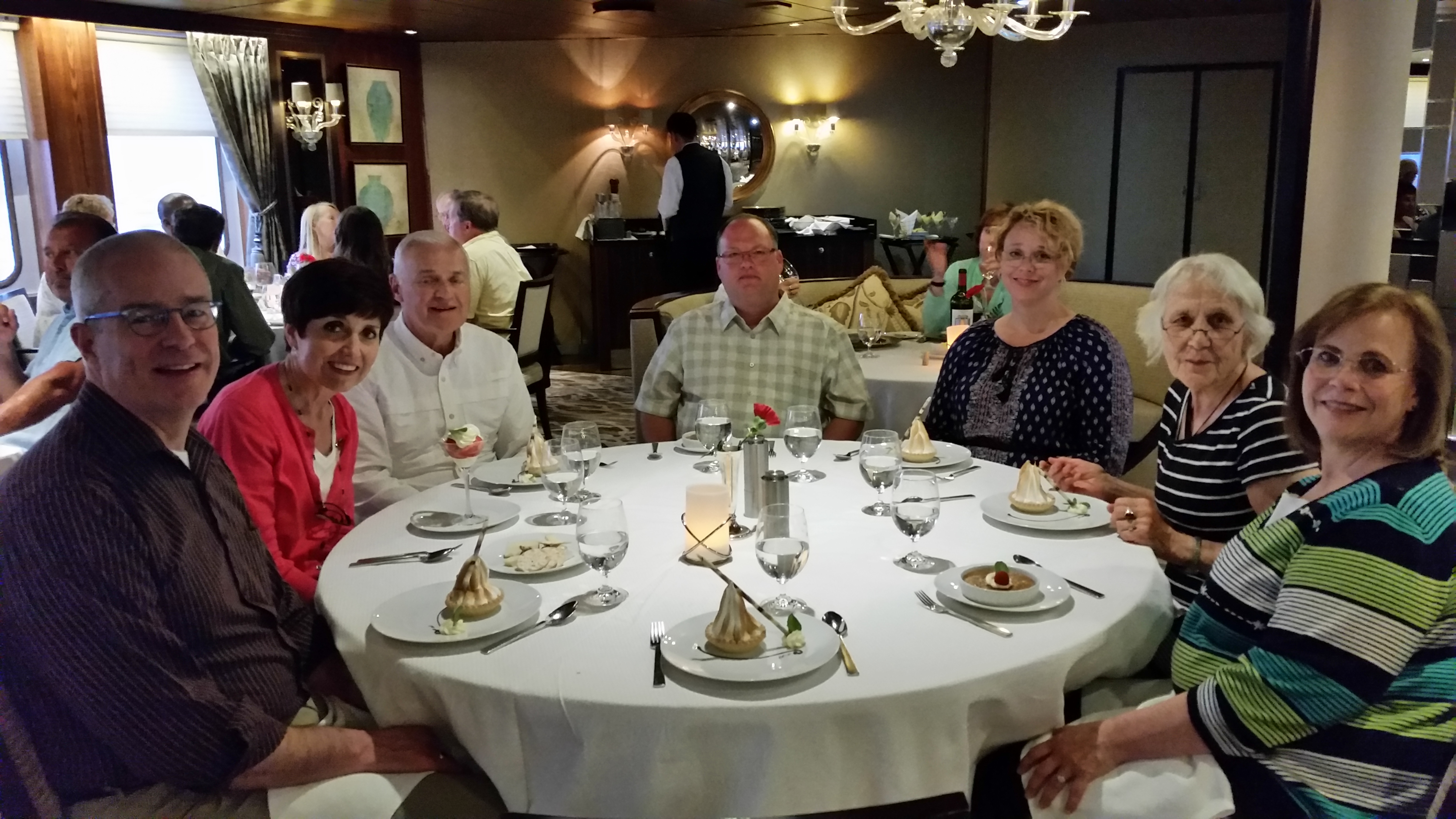
Dinner with Eva, Barry, Jeff, Patty, Amanda and Joyce
Seated once again in “Yusuf Kingdom,” tonight we shared a table with Barry and Eva (recovering nicely from the falling branch incident) and “the clan” (the name Jim has applied to Amanda and the family members accompanying her). Nancy began dinner with beef carpaccio: paper-thin slices of rare meat topped with crunchy asparagus and radishes; Michael had a tasty spinach, watermelon, and feta salad. For the entree, Nancy chose lamb biryani (our menus have usually included Indian dishes because the head chef is from Andhra-Pradesh); Michael had Beef Wellington.
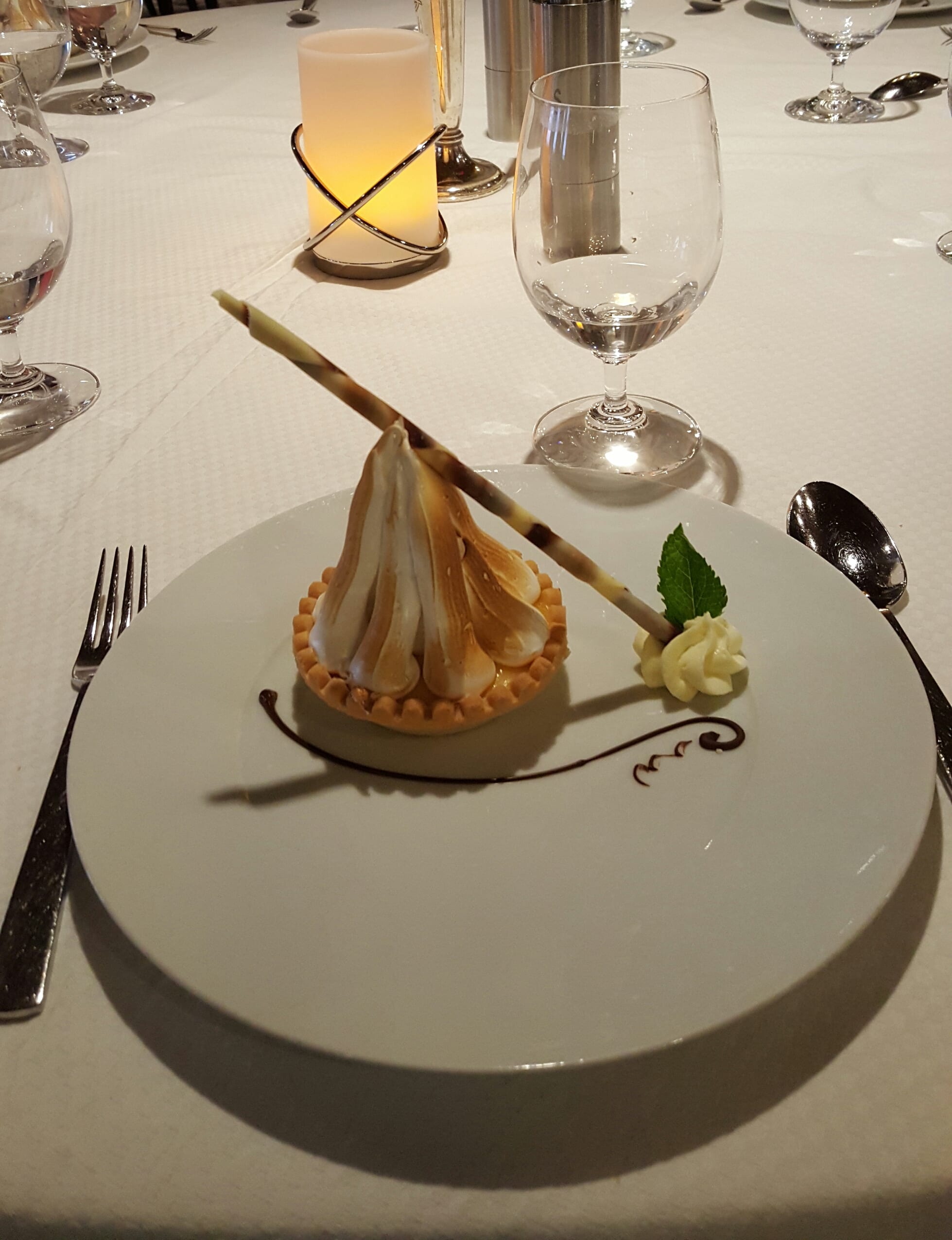
Lemon meringue tart
As we finished dessert (the lemon meringue tarts were disappointing because the dense meringue–more like marshmallow fluff–overpowered the citrus tang) and sat talking about aquifers and water rights with the denizens of northwestern Utah, Michael started feeling a little lightheaded. Eventually he realized that it was because the ship had begun listing to and fro more noticeably than at any time since we had embarked–enough to require gripping the handrails as we made our way back to stateroom 111. He was afraid that the obvious movement would make sleep impossible. Au contraire, the gentle rocking actually help us fall asleep pretty quickly and continue soundly through the night.
Great job Nancy and Michael. Reminded me of many things I have already forgotten. Does that make sense?
Thank you for taking the time to do this.